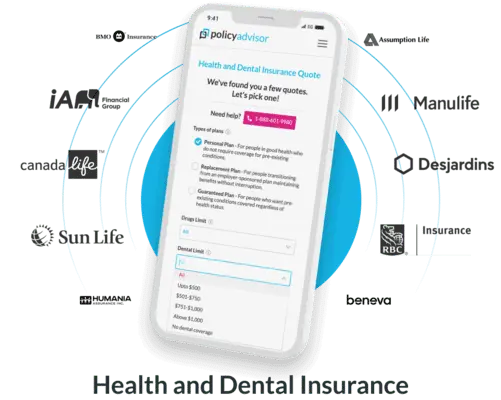Protect Your Health. Secure Your Future.
Get comprehensive, affordable health insurance plans tailored to your needs from trusted providers.
Trusted Providers. Tailored Quotes.
We have partnered with Canada’s leading insurance companies so you can find the right plan in one place.
What is private health and dental insurance?
Private health and dental insurance in Canada provides coverage for medically necessary and elective services that the public healthcare system does not fully cover or at all. While provincial and territorial plans guarantee core services like physician visits, hospitalizations, and surgeries, they rarely cover routine dental care, prescription drugs, vision care, paramedical treatments (e.g., physiotherapy, chiropractic care), or preventative services.
For individuals and families, private plans act as a strategic extension of public coverage and allow access to a broader network of providers, faster treatment timelines, and financial protection against out-of-pocket medical expenses. The structure and cost of these plans are influenced by factors such as age, health status, province of residence, and the breadth of coverage, including whether the plan accommodates pre-existing conditions or specialized therapies.
Why should I compare health and dental insurance quotes?
Comparing quotes for private health insurance in Canada is crucial to finding coverage that fits your needs and budget. Premiums and benefits can differ significantly between insurers, even for plans that appear similar. Without comparing options, you risk paying more than necessary or selecting a plan with gaps in essential coverage, such as prescription drugs, dental procedures, vision care, and paramedical services.
By comparing insurance plans, you can evaluate both cost and value, and identify options that offer comprehensive care while remaining affordable. This process also helps highlight differences in coverage limits, exclusions, waiting periods, and optional benefits that can impact your healthcare experience. For individuals and families, reviewing multiple health and dental insurance quotes ensures your plan is customized to your circumstances, whether you need coverage for dependents, pre-existing conditions, or specialized services beyond provincial healthcare.
What does private health insurance cover?
Personal health insurance plans often include benefits such as:
Prescription Drugs
Antibiotics, narcotics, creams, etc.
Paramedical Expenses
Mental health services, physiotherapy, registered massage therapy (RMT), chiropractic, etc.
Medical Equipment
Crutches, nebulizers, CPAP machines, etc.
Dental Treatment
Teeth cleaning, braces, crowns, etc.
Vision Care
Glasses, contact lenses, eye exams, etc.
Travel Medical
Emergency medical expenses
Cost of health and dental insurance in Canada
In Canada, the cost of health and dental insurance depends on the type of plan you choose. Personal health insurance for individuals can start around $60–$100 per month for younger adults and rise to $300 or more for seniors, while family plans often range from $160 to $800 per month.
Guaranteed issue plans or policies that cover pre-existing conditions generally cost more, often beginning at about $100 per month and increasing with age and coverage needs. These are only averages—actual premiums vary by age, health status, province, and insurer—so comparing multiple providers is the best way to find affordable coverage

Why choose PolicyAdvisor for health and dental insurance quotes?
Finding the right health and dental insurance in Canada shouldn’t be complicated. PolicyAdvisor gives you a simple, transparent way to compare plans, understand your options, and get covered—all in one place. Here’s why Canadians trust us:
- Compare top providers within minutes: View quotes from Canada’s leading health and dental insurers side by side. No need to jump between websites or talk to multiple brokers
- Save money without losing coverage: See competitive rates at a glance, so you can balance affordability with comprehensive protection for prescription drugs, dental care, vision, and more
- Plans customized for your needs: Whether you’re self-employed, between jobs, retired, or just need extra coverage beyond provincial healthcare, we’ll match you with a plan that fits your lifestyle
- Clear, jargon-free guidance: We break down coverage details, exclusions, and costs in plain language. You’ll always know what’s included with no hidden fees or surprises
- Fast and secure online application: Apply in minutes and get your policy documents digitally. Everything is secure, paperless, and travel-ready
- Expert advisor support: Our experienced advisors help answer all your questions, compare plan types, and guide you every step of the way
What should I ask before buying private medical insurance with dental coverage?
Choosing private medical insurance in Canada is an important decision, and asking the right questions helps you avoid gaps in coverage or unexpected costs. Before you buy, make sure to ask:
What is the annual maximum, and are there per-service limits?
Private medical insurance usually includes both an overall coverage cap and service-specific limits. For example, vision care may have a $200 cap every two years, while paramedical care could be limited to $500 per practitioner annually. Always confirm both types of limits.
What are the waiting periods for basic and major dental?
Basic dental services such as exams, cleanings, and fillings may be covered immediately, while crowns, bridges, dentures, and orthodontics often require a waiting period of 6–12 months.
What is the reimbursement rate and deductible?
Plans generally reimburse between 70% and 100% of eligible expenses. Ask what deductible applies since \this is the amount you must pay before your private health insurance coverage begins.
How are pre-existing conditions defined and treated?
Most insurers require conditions to be “stable” for a set period (commonly 3–12 months) before coverage applies. Some providers may exclude pre-existing conditions entirely or limit coverage. Always get a written explanation before applying.
Is direct billing available for pharmacies, dental clinics, and paramedical providers?
Direct billing can save you from paying upfront and waiting for reimbursement. Confirm whether your insurer has a provider network that supports this.
Does the plan include emergency out-of-country medical coverage?
Not all private medical insurance includes travel benefits. If you travel frequently, confirm whether the plan covers medical emergencies abroad, including evacuation or repatriation.
What is the claims process and turnaround time?
Ask whether claims can be submitted online or by app, what documentation is required, and the average reimbursement time. Digital claims portals often process payments within a few business days, while paper claims may take longer.
Get health and dental insurance quotes today!
Choosing the right health and dental plan is one of the best ways to protect yourself and your family from out-of-pocket medical costs not covered by provincial healthcare. Our health and dental insurance quotes tool helps you compare and buy coverage in just minutes.
- Compare plans from Canada’s top insurers
- Review coverage levels for prescription drugs, dental care, vision, hospital stays, and more
- Explore options for individuals, families, retirees, or self-employed Canadians
- Customize deductibles and benefits to match your budget and needs
- Apply online quickly and securely, today!
Get your health and dental insurance quote today and get peace of mind knowing you have protection for everyday care and unexpected expenses.
Frequently asked questions

























